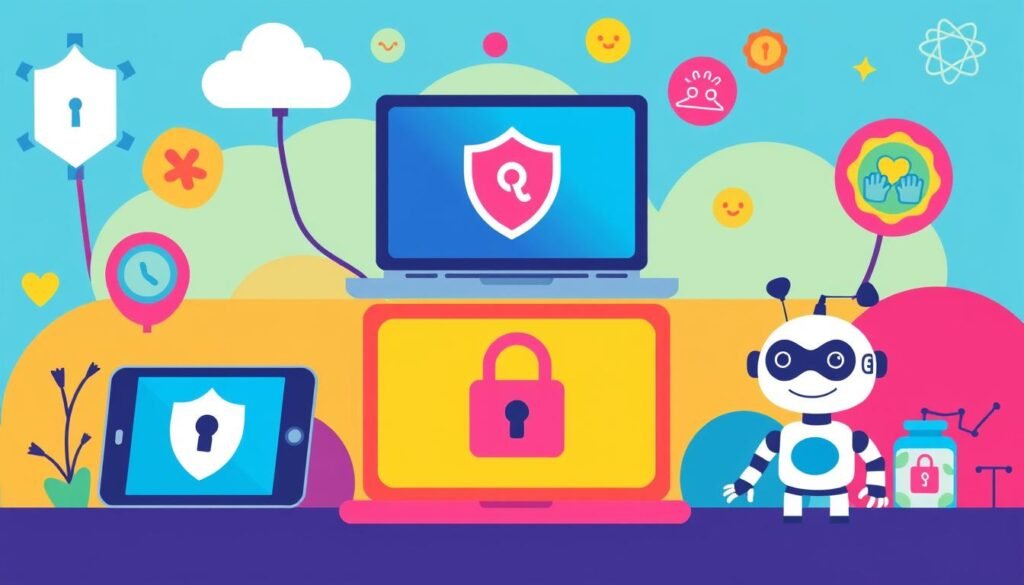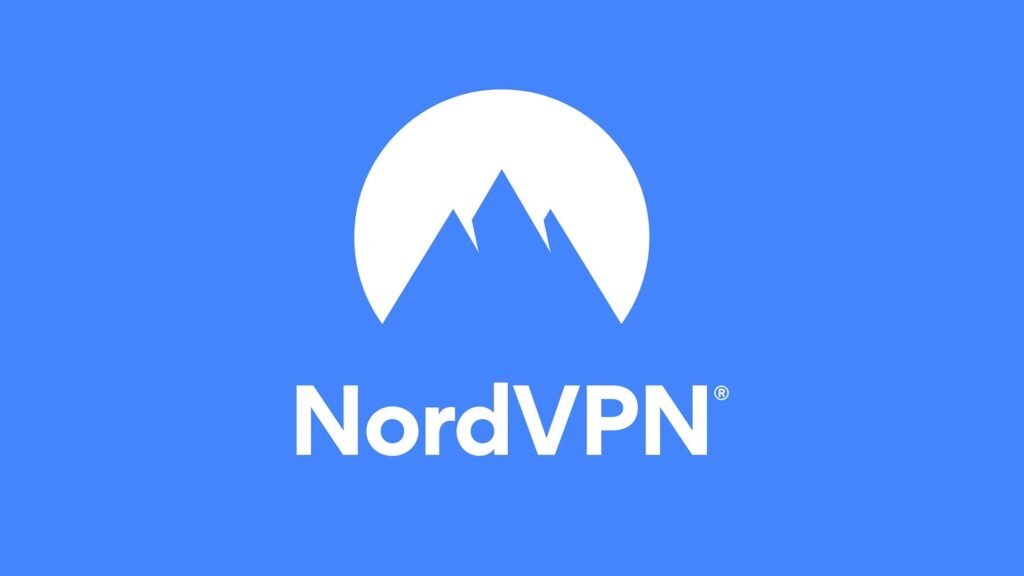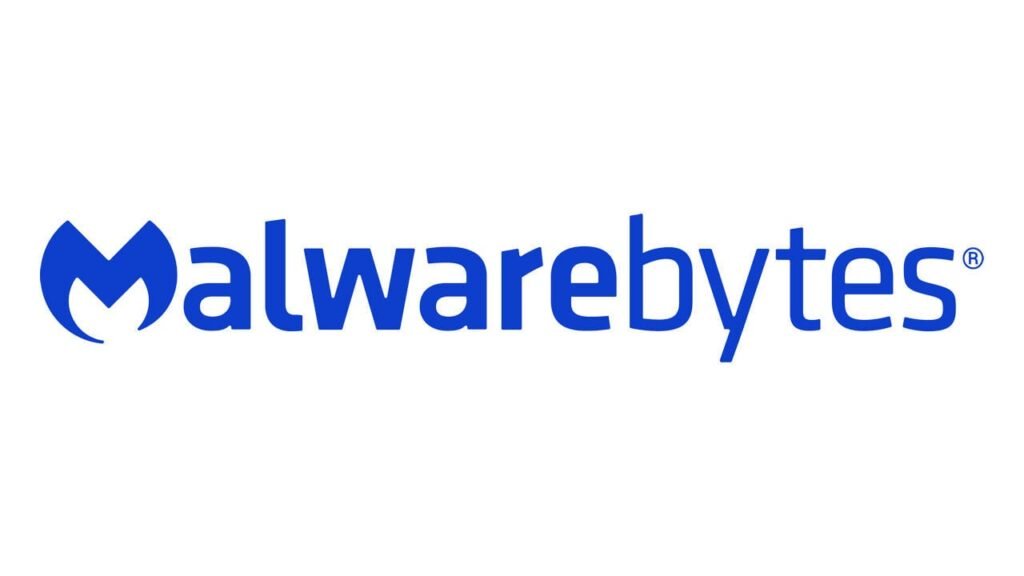Did you know that only 40% of parents talk about internet safety with their kids? This leaves many kids open to online dangers1. In today's world, it's vital to teach kids how to stay safe online. They spend a lot of time on different platforms.
Studies show that 37% of young internet users have faced cyberbullying. This highlights the need for good education on cybersecurity for kids1. Using resources like the National Cybersecurity Alliance and talking openly with your kids can help them understand online risks better. It's important to teach them about phishing scams, which cause 90% of cyberattacks1.
By having real talks and teaching the right online safety tips, you can help your kids make smart choices online. This is crucial in a world full of digital challenges.
Key Takeaways
- • Only 40% of parents discuss internet safety with their children regularly.
- • Around 37% of young internet users have experienced cyberbullying.
- • 90% of successful cyberattacks originate from phishing scams.
- • Establishing clear communication about online safety is crucial.
- • Resources like the National Cybersecurity Alliance can be beneficial for children's cybersecurity education.
Understanding the Importance of Online Safety for Kids
In today's world, it's crucial to teach kids about online safety. About 75% of students get their news from social media. This means kids need to know how to stay safe online2. Knowing about online dangers can help prevent cyberbullying and privacy issues.
The Children's Online Privacy Protection Act (COPPA) says kids under 13 need protection online. It requires parents to agree before any personal info is shared3. Kids should not share personal info or meet strangers without a parent's okay3. Since 40% of kids in grades 4 to 8 talk to strangers online, teaching them is key2.
Parents are very important in teaching kids about online safety. They should spend time online with their kids and talk about any problems3. Signs that a child might be in danger include spending too much time online, getting unwanted gifts, and pulling away from family3. These signs help parents act fast to protect their kids.
Also, 70% of job recruiters won't hire someone with bad online info. So, kids need to learn about keeping a good online image4. Parents should talk about password safety and the risks of social media4. This helps kids stay safe and responsible online.
How to Teach Kids About Online Safety and Cybersecurity
Teaching kids about online safety is key in today's digital world. Talking openly about technology helps create a safe space. Here, kids can share their thoughts and worries without fear.
By being open, you help them understand online risks better. This understanding leads to safer online behaviors.
Engage in Open Discussions on Technology
Start talking about their online experiences. This opens up crucial conversations about staying safe online. By facing these challenges together, you help them spot dangers.
A survey shows 37% of kids have faced online dangers like bullying. This shows why these talks are so important5.
Introduce the Concept of Cybersecurity Early
Teach kids about cybersecurity early. This helps them know the risks and how to stay safe. The K-12 Computer Science Framework helps standardize computer science education, which is vital for young learners6.
Using real-life examples makes learning cybersecurity easier for kids. There are many lesson plans for grades K–12. They cover important topics like staying safe online and protecting privacy7.
Practical Online Safety Tips for Kids
To keep your kids safe online, it's crucial to teach them about online safety. Start by teaching them to share safely. Tell them to think before sharing personal info online, just like they would in real life. This means not sharing their full name, address, or school to avoid unwanted attention.
Encouraging Safe Sharing Practices
Teach your kids to be careful about who they talk to online. Explain that they should only talk to people they know in real life. Show them how to use social media settings to control who sees their stuff. Use tools like Be Internet Awesome to teach them about staying safe online8.
Make sure they know to tell a trusted adult if they feel uncomfortable or see something strange online. This way, they'll feel safe talking about their online experiences.
Identifying and Avoiding Online Dangers
Teach your kids to spot online dangers. Warn them about messages or offers that seem too good to be true. These could be scams. In 2021, over 95,000 people lost money to fraud on social media, with losses of around $770 million9.
Encourage them to ask questions before clicking on links or downloading things from unknown sources. Teach them to think critically about what they see online.
Protecting Children Online: Tools and Resources
In today's digital world, tools for protecting children online are key for their safety. Research shows that 72 percent of kids worldwide have faced cyber threats. This highlights the need for strong protection10. With 94 percent of kids aged three to 18 using the internet at home, parents must teach them about online safety10.
Parental control software is a crucial tool. It lets you watch what your kids see online and block bad content. Also, using antivirus software with anti-malware and firewall is important to fight threats like clickjacking10. Keeping these tools up to date is essential to avoid security issues10.
Education is also vital. Groups like the National Cybersecurity Alliance offer materials for parents and teachers. Programs like NetSmartz teach kids about online safety and privacy. But, only 39 percent of parents say their kids tell them when they feel unsafe online10.
Parents should also use secure tracking apps to keep an eye on their kids. This helps ensure their safety while knowing where they are10. With 93 percent of kids aged 12 to 17 online and 75 percent with cell phones, teaching them about safety is crucial11.

In summary, using tools and resources is key to keeping kids safe online. From parental control software to educational programs, these steps help kids understand and safely use the internet.
| Tool/Resource | Description | Benefits |
|---|---|---|
| Parental Control Software | Applications that help monitor and restrict children’s online activities | Increased protection against inappropriate content |
| Antivirus Software | Tools that defend against malware and other cyber threats | Protection from viruses, spyware, and unauthorized access |
| Educational Programs | Resources like NetSmartz for teaching online safety | Empowerment through knowledge and skills for safe internet use |
| Tracking Apps | Applications for monitoring child's location securely | Enhanced safety and awareness of potential risks |
Creating Guidelines for Safe Internet Usage
It's key to set up internet usage guidelines for kids to keep them safe online. Kids and teens spend a lot of time on screens, from 4 to 6 hours a day for 8-12 year olds and up to 9 hours for teens12. It's important to have rules that show what's okay and what's not online.
Develop Family Rules for Online Activity
Make clear rules for what's okay online. These rules help avoid dangers like talking to strangers and keeping personal info private. Teach kids to only share with people they trust, showing them that personal information is as valuable as money12.
Set Boundaries for Screen Time
It's crucial to limit screen time to keep a healthy balance. Set daily limits for device use. Use parental controls to make sure they see only what's right for their age12. This helps them stay healthy and enjoy other activities too.
Having a mix of online and offline activities helps kids understand and follow internet usage guidelines for kids. It keeps their online time safe and fun.
Online safety is a shared responsibility, and fostering open conversations about managing screen time and online behavior can go a long way in safeguarding children.
| Screen Time Recommendations | Age Group | Recommended Daily Limit |
|---|---|---|
| 4-6 hours | Children (8-12 years) | Maximum 2 hours of recreational screen time |
| 9 hours | Teens | Maximum 2-3 hours of recreational screen time |
Teaching kids to manage screen time wisely helps them stay safe online. It also prepares them for a world where being safe online is very important.
The Role of Parents in Cyber Education
In today's digital world, parents play a key role in keeping their kids safe online. They are the first line of defense, teaching their children about cyber safety. This is especially important since teens often act carelessly online14.
Starting with open talks about their online activities is crucial. Encourage your kids to share any worries they have. This can help avoid future cyber problems14.
Setting limits on screen time is also important. For younger kids, a few minutes a day is enough. Teenagers might need a few hours, but it should be safe14. Using parental control software can help keep your network secure. It lets you watch what they do online, block bad content, and stop them from visiting dangerous sites.
Teaching your kids about online safety is key. Show them how to spot scams, stay away from risky sites, and keep personal info private. This approach is more effective than scaring them about the internet14. With 73% of teens unable to imagine life without smartphones and 44% of kids aged 8 to 16 always online, it's more important than ever to guide them15.
Stay ahead by updating your protection software, backing up important files, and knowing who to call if something goes wrong online. The fact that 40% of kids share personal info online, like their home address, shows how crucial it is for parents to be involved15.

| Concern | Statistic |
|---|---|
| Smartphone Dependency | 73% of teenagers can't imagine life without a smartphone. |
| Online Activity | 44% of kids aged 8 to 16 are online constantly. |
| Sensitive Information Sharing | 40% of children have shared their home address online. |
| Online Dangers | 37% of kids have encountered online dangers including bullying and inappropriate content. |
Teaching Kids About Cyberbullying
It's important to teach kids about cyberbullying in today's digital world. Knowing about harmful online actions is the first step to stop them. This includes things like harassment, being left out, or spreading false rumors. It's key for teachers and parents to talk about these issues with kids.
Recognizing Cyberbullying Behavior
To teach kids to fight bullying, they need to know what cyberbullying is. This means spotting actions like:
- • Harassing messages or posts
- • Exclusion from online groups or activities
- • Spreading false information
By talking to kids about these topics, they learn to spot bad online behavior. Adults should stress the need to stay alert and have open talks about what they see.
Empowering Kids to Stand Against Bullying
It's vital to create a space where kids feel brave to speak up against bullying. Instead of telling them to ignore problems, teach them to report and support victims. Tools like Digital Passport games help kids learn good online habits16. Starting programs like the New York State ‘Kids Safe Online' Poster Contest also helps kids have a voice17.
Teaching kids to stand up for themselves and others builds a kind and responsible community.
Kid-Friendly Cybersecurity Lessons
Teaching your kids about online security is key in today's tech world. Cybersecurity lessons for children can greatly impact their digital safety knowledge. Fun ways include interactive games and multimedia for young learners. For example, NetSmartz and PBS CyberChase offer educational content for kids.
It's worrying that 73% of teens can't imagine life without a smartphone. Also, 44% of kids aged 8 to 16 are always online. Kids often take risks, like 40% sharing sensitive info online18. Programs like Cyberfit Nation offer free workshops to teach online safety skills19.
Activities in Cyber A.C.E.S. are made for kids aged 5 to 15. They learn safety lessons at the right age19. Adding these to school curricula helps kids grow safely and academically
The Be Internet Awesome curriculum teaches five digital safety topics. It keeps kids engaged and motivated while learning about cybersecurity in a fun way20.
By teaching online safety in a fun and interactive way, you can help your child understand cybersecurity better. These lessons will not only inform but also encourage critical thinking about their online presence.
Encouraging Critical Thinking Online
Teaching kids to think critically online is key to their safety on the internet. It's important to teach them how to check if online sources are trustworthy. This skill is crucial for online safety.
Studies show that kids who learn about cybersecurity are more likely to stay safe online. They also know how to tell adults about any online dangers they find21. Talking to them about using strong passwords, like three random words, helps them understand security better22.
It's important to talk to kids about not sharing passwords. This teaches them the value of keeping their passwords private. Learning from resources like Thinkuknow and The National Cyber Security Centre can make these lessons more engaging22.
Teaching kids how to report online problems can make them feel more in control. Setting limits on screen time is also a chance to talk about a healthy balance between online and offline life22.
Helping kids understand and deal with cyberbullying is vital. It's important for both kids and parents to know about this issue. Cybersecurity expert Bruce Schneier says security is a continuous learning process, not just a one-time thing21.
| Action | Description |
|---|---|
| Assess Source Credibility | Teach children to question the reliability of information they encounter online. |
| Strong Password Practices | Encourage the use of complex passwords by combining three random words. |
| Engagement in Activities | Participate in cybersecurity activities to enhance awareness and skills. |
| Device Controls | Set restrictions on devices to manage screen time and content accessibility. |
| Cyberbullying Awareness | Discuss the signs of cyberbullying and how to report it effectively. |
Conclusion
Kids' online safety education is key in today's digital world. Children face dangers like cyberbullying, identity theft, and bad content. It's vital to teach them how to use the internet safely23.
Parents and teachers can help a lot by talking openly about tech and using learning plans. This way, kids learn about staying safe online24. With more cyber threats aimed at kids, teaching them how to handle these dangers is crucial25.
The internet offers many chances, but it also brings big responsibilities. Teaching kids to think critically and be kind online is important. They should also learn to spot phishing scams23.
Parents play a huge role in keeping kids safe online. They help create a safe space where kids feel safe and protected24. As the digital world keeps changing, teaching kids about online safety will always be important.




